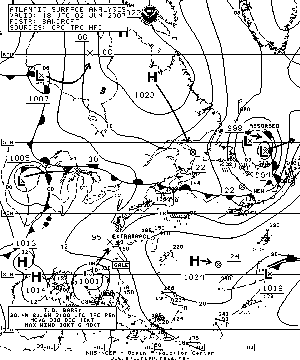Do you want HF Marine Weather to continue?
by US Coast Guard on 3 Jun 2007

HF Weatherfax SW
The United States Coast Guard is soliciting public comment on the need to continue providing high frequency (HF) radio broadcasts of weather forecasts and warnings. Public comment is necessary in order to assess the demand for the HF radio broadcasts of weather forecasts in each of three forms:
(1) Radiofacsimile; (2) voice; and, (3) Simplex Teletype Over Radio (SITOR), also known as Narrow Band Direct Printing (NBDP).
The infrastructure necessary to provide these services has exceeded its life
expectancy; the equipment is no longer manufactured, repairs are difficult to
accomplish, and spare parts generally are not available.
Because of the very significant costs involved to continue these specific HF radio services, the Coast Guard requires information on the extent to which these services are used by the public and what alternative services are being used or are available to obtain weather forecasts and warnings.
Comments should be submitted by August 24.
Read the notice at http://www.navcen.uscg.gov/marcomms/high_frequency/FR_HF_WX_Notice.pdf
and submit your comments to the Docket Management Website
The USCG Navigation Center Team
http://www.navcen.uscg.gov/
Background and Purpose: The Coast Guard broadcasts the National Oceanic and Atmospheric Administration¡¯s (NOAA) National Weather Service (NWS) weather
forecasts and warnings using 24 high frequency (HF) radio transmitters
(transmitting on frequencies between 3 and 30 MHz) located at seven Coast
Guard communications stations in the United States and Guam.
The range of these HF radio transmissions is dependent upon operating frequency, time of day and atmospheric conditions, and can vary from only short distances to several thousand miles.
There are three types of HF radio broadcasts currently provided: (1) Voice broadcasts that transmit a synthesized voice to announce the forecasts); (2) radiofacsimile, also known as ¡®¡®radiofax¡¯¡¯ or ¡®¡®HF Fax¡¯¡¯ broadcasts, that transmit graphic weather maps and other graphic images over HF radio (maps are received using a dedicated radiofax receiver or a single sideband shortwave receiver connected to an external facsimile recorder or a personal computer equipped with a radiofax interface and application software); and, (3) Simplex Teletype Over Radio (SITOR) broadcasts also known as Narrow Band Direct Printing (NBDP).
The 24 HF transmitters employed to transmit weather forecasts and warnings
are not, because of their age, providing the reliability the Coast Guard expects from its radio transmitters.
These particular transmitters are no longer manufactured and replacement parts generally are not available, making it difficult, if not impossible, to repair them. If the HF weather broadcasts are to continue, the infrastructure necessary for the broadcasts must be replaced.
Significant costs will be incurred to replace the requisite transmitters and
associated infrastructure. Before seeking funds for this undertaking, the Coast
Guard must gather evidence relating to how frequently, and under what
circumstances, the maritime community uses the various types of HF radio
weather broadcasts.
In addition, it would be helpful to learn about current and future needs of the maritime community with regard to receiving weather forecasts and warnings over HF radio, and what alternatives are being used or might become available.
Questions: The following are questions related to Coast Guard HF radio broadcasts on which we seek your comments. It would be helpful if commenters would answer the question as specifically as possible, and then provide explanations, if any, for the responses.
(1) What is your position in the maritime community? (Please be as specific as possible, e.g., captain of 600¡ä oil tanker, 1st mate on 500 unit containership, owner/operator of 45¡ä cruising sailboat, fleet manager of a 27
vessel shipping company, yacht delivery captain, etc.)
(2) What are your primary sources for obtaining marine weather forecasts? (For
example, Inmarsat-C/SafetyNet, USCG HF radio broadcasts, USCG medium
frequency (MF) Radio Broadcasts, USCG very high frequency (VHF) radio
broadcasts, NOAA Weather Radio, NAVTEX, shoreside Internet, radio/
television, commercial service/system, etc.)
(3) Do you use Coast Guard HF radio voice broadcasts to receive marine
weather forecasts? (Yes or No) If yes, how often do you use Coast Guard HF
voice broadcasts and how critical are they to your safety and operation as
compared to the other sources you listed in your response to Question 2?
(4) Do you use Coast Guard HF radiofax broadcasts to receive marine
weather forecasts? (Yes or No) If yes, how often do you use Coast Guard HF
radiofax broadcasts and how critical are they to your safety and operation as
compared to the other sources you listed in your response to Question 2?
(5) Do you use Coast Guard HF radio Simplex Teletype over Radio (SITOR)
(also known as Narrow Band Direct printing (NBDP)) to receive marine
weather forecasts? (Yes or No) If yes, how often do you use Coast Guard
SITOR radio broadcasts and how critical are they to your safety and operation as
compared to the other sources you listed in your response to Question 2?
(6) What alternative source(s) for obtaining marine weather forecasts
would you pursue if Coast Guard HF broadcasts were no longer available?
How would you rate the alternative source(s) in terms of (a) user cost and (b)
usefulness of the information as compared to the Coast Guard HF broadcast it replaces?
(7) Would the loss of Coast Guard HF marine weather broadcasts affect you?
Please explain.
(8) How far seaward does your vessel primarily operate? (For example, coastal
(0¨C25 nautical miles (nm) seaward); offshore (25¨C200 nm seaward); or, high
seas (more than 200 nm seaward.) In what geographic area(s) do you
generally operate your vessel? (For example, mid-Atlantic, New England,
North Central Pacific, Hawaii, Gulf of Mexico, etc.)
As noted previously, comments regarding these questions, and any other
pertinent matters brought to our attention during the comment period,
will be taken into account in our future actions regarding the issues raised by
these questions.
Dated: April 18, 2007.
C.S. Johnson, JR.,
Captain, U.S. Coast Guard, Acting Assistant Commandant for Command, Control,
Communications, Computers and Information Technology.
If you want to link to this article then please use this URL: www.sail-world.com/34253